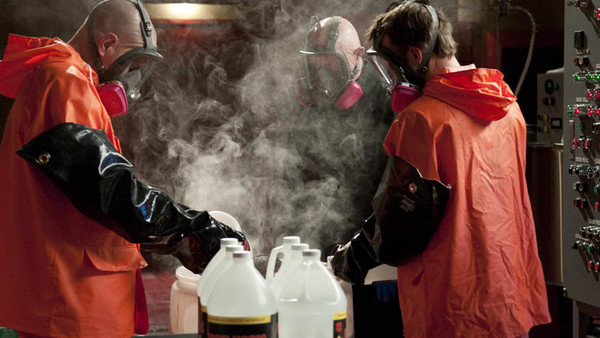10 Chemicals You Really SHOULD Be Scared Of
8. Hydrofluoric acid

Sure, something you swallow, or inhale, could kill you. But a small quantity of liquid spilled on your skin? That couldn't possibly be fatal, could it? Surely, if you washed it off quickly enough, you'd be fine?
Not if it's hydrofluoric acid, the acid which forms when fluorine gas reacts with water.
In 1995 a chemist working in Australia was sitting working at a fume cupboard and knocked over 100-230 millilitres (the equivalent of a small drinking glass) of hydrofluoric acid onto his lap, splashing both thighs. He immediately washed his legs with water, jumped into a chlorinated swimming pool at the rear of the workplace, and stayed there for about 40 minutes before an ambulance arrived.
It wasn't enough. His condition deteriorated in hospital and, despite having his right leg amputated 7 days after the accident, he died from multi-organ failure 15 days after the spill.
Hydrofluoric acid is terrifying stuff. It's a contact-poison that causes deep, often initially painless burns which, are not felt to begin with and can be easily missed. That's until the pain starts the day after, and the horrific damage becomes obvious. Exposure results in permanent tissue death and interferes with calcium metabolism leading to cardiac arrest and death.
Funnily enough, in chemistry parlance, it's actually a 'weak' acid. However, weak does not necessarily mean safer. It just means that, in water, only a small number of HF molecules break up to form H+ and F- ions. This matters little, because with this particular substance it's not so much the hydrogen ions that are doing the damage - as is the case with most acids - but the fluorine. As soon as that fluorine meets some calcium, insoluble calcium fluoride forms. The result is that blood calcium levels drop precipitously, putting the victim at risk of cardiac arrest. It also, not surprisingly, destroys bone - which can lead to amputation. Actually, the fact that HF is a weak acid makes it more dangerous if anything - because it doesn't form ions, it dissolves more easily in fats, which means it's absorbed through the skin more easily.
There are good reasons to use hydrofluoric acid - it etches silica, which makes it important for preparing microchips - but anyone who is using it ought to have an emergency kit containing calcium gluconate readily to hand which renders it harmless.
By the way, that reaction with silica means that hydrofluoric acid can't be stored in plain glass bottles. Because it eats through them. Be afraid. Very afraid.